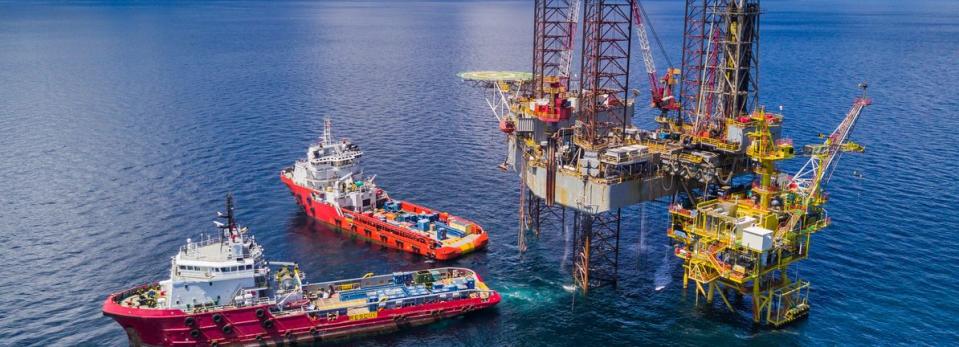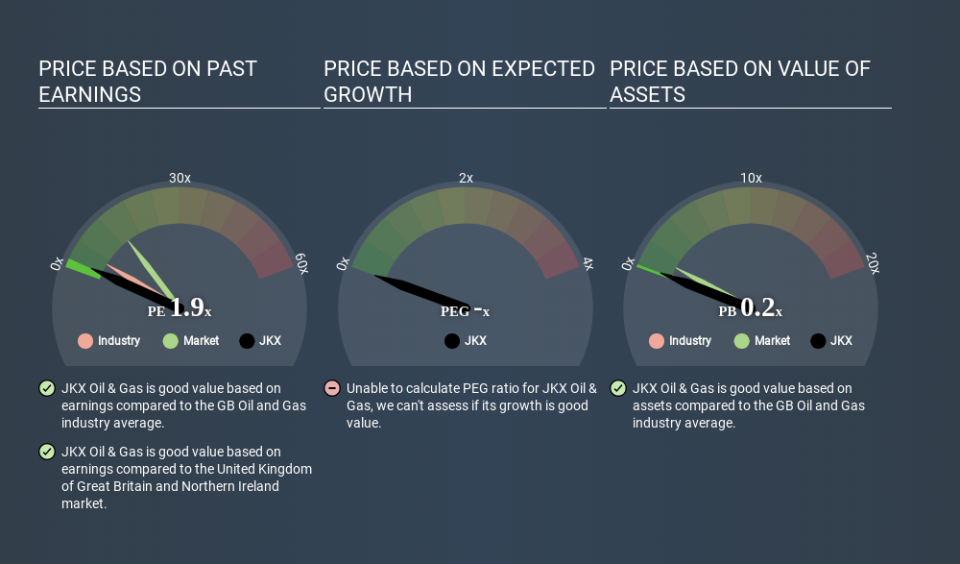Does JKX Oil & Gas plc (LON:JKX) Have A Good P/E Ratio?

This article is written for those who want to get better at using price to earnings ratios (P/E ratios). We'll look at JKX Oil & Gas plc's (LON:JKX) P/E ratio and reflect on what it tells us about the company's share price. Looking at earnings over the last twelve months, JKX Oil & Gas has a P/E ratio of 1.88. That is equivalent to an earnings yield of about 53.3%.
View our latest analysis for JKX Oil & Gas
How Do I Calculate A Price To Earnings Ratio?
The formula for price to earnings is:
Price to Earnings Ratio = Price per Share (in the reporting currency) ÷ Earnings per Share (EPS)
Or for JKX Oil & Gas:
P/E of 1.88 = $0.226 ÷ $0.120 (Based on the year to December 2019.)
(Note: the above calculation uses the share price in the reporting currency, namely USD and the calculation results may not be precise due to rounding.)
Is A High Price-to-Earnings Ratio Good?
The higher the P/E ratio, the higher the price tag of a business, relative to its trailing earnings. That isn't a good or a bad thing on its own, but a high P/E means that buyers have a higher opinion of the business's prospects, relative to stocks with a lower P/E.
Does JKX Oil & Gas Have A Relatively High Or Low P/E For Its Industry?
The P/E ratio indicates whether the market has higher or lower expectations of a company. We can see in the image below that the average P/E (4.8) for companies in the oil and gas industry is higher than JKX Oil & Gas's P/E.
Its relatively low P/E ratio indicates that JKX Oil & Gas shareholders think it will struggle to do as well as other companies in its industry classification. Since the market seems unimpressed with JKX Oil & Gas, it's quite possible it could surprise on the upside. It is arguably worth checking if insiders are buying shares, because that might imply they believe the stock is undervalued.
How Growth Rates Impact P/E Ratios
Probably the most important factor in determining what P/E a company trades on is the earnings growth. When earnings grow, the 'E' increases, over time. And in that case, the P/E ratio itself will drop rather quickly. So while a stock may look expensive based on past earnings, it could be cheap based on future earnings.
JKX Oil & Gas's earnings made like a rocket, taking off 70% last year.
Remember: P/E Ratios Don't Consider The Balance Sheet
Don't forget that the P/E ratio considers market capitalization. That means it doesn't take debt or cash into account. The exact same company would hypothetically deserve a higher P/E ratio if it had a strong balance sheet, than if it had a weak one with lots of debt, because a cashed up company can spend on growth.
Spending on growth might be good or bad a few years later, but the point is that the P/E ratio does not account for the option (or lack thereof).
JKX Oil & Gas's Balance Sheet
JKX Oil & Gas has net cash of US$15m. This is fairly high at 39% of its market capitalization. That might mean balance sheet strength is important to the business, but should also help push the P/E a bit higher than it would otherwise be.
The Verdict On JKX Oil & Gas's P/E Ratio
JKX Oil & Gas trades on a P/E ratio of 1.9, which is below the GB market average of 14.1. It grew its EPS nicely over the last year, and the healthy balance sheet implies there is more potential for growth. The below average P/E ratio suggests that market participants don't believe the strong growth will continue.
Investors should be looking to buy stocks that the market is wrong about. If it is underestimating a company, investors can make money by buying and holding the shares until the market corrects itself. So this free report on the analyst consensus forecasts could help you make a master move on this stock.
Of course, you might find a fantastic investment by looking at a few good candidates. So take a peek at this free list of companies with modest (or no) debt, trading on a P/E below 20.
If you spot an error that warrants correction, please contact the editor at editorial-team@simplywallst.com. This article by Simply Wall St is general in nature. It does not constitute a recommendation to buy or sell any stock, and does not take account of your objectives, or your financial situation. Simply Wall St has no position in the stocks mentioned.
We aim to bring you long-term focused research analysis driven by fundamental data. Note that our analysis may not factor in the latest price-sensitive company announcements or qualitative material. Thank you for reading.

 Yahoo Finance
Yahoo Finance 
